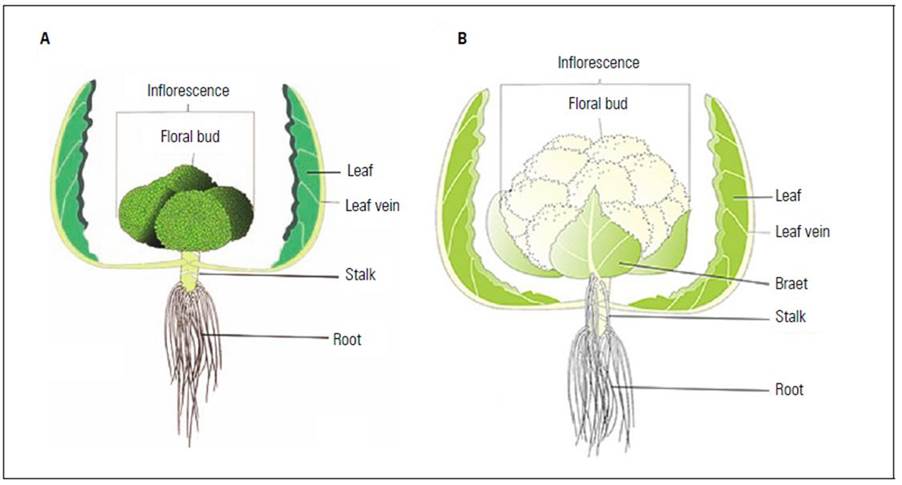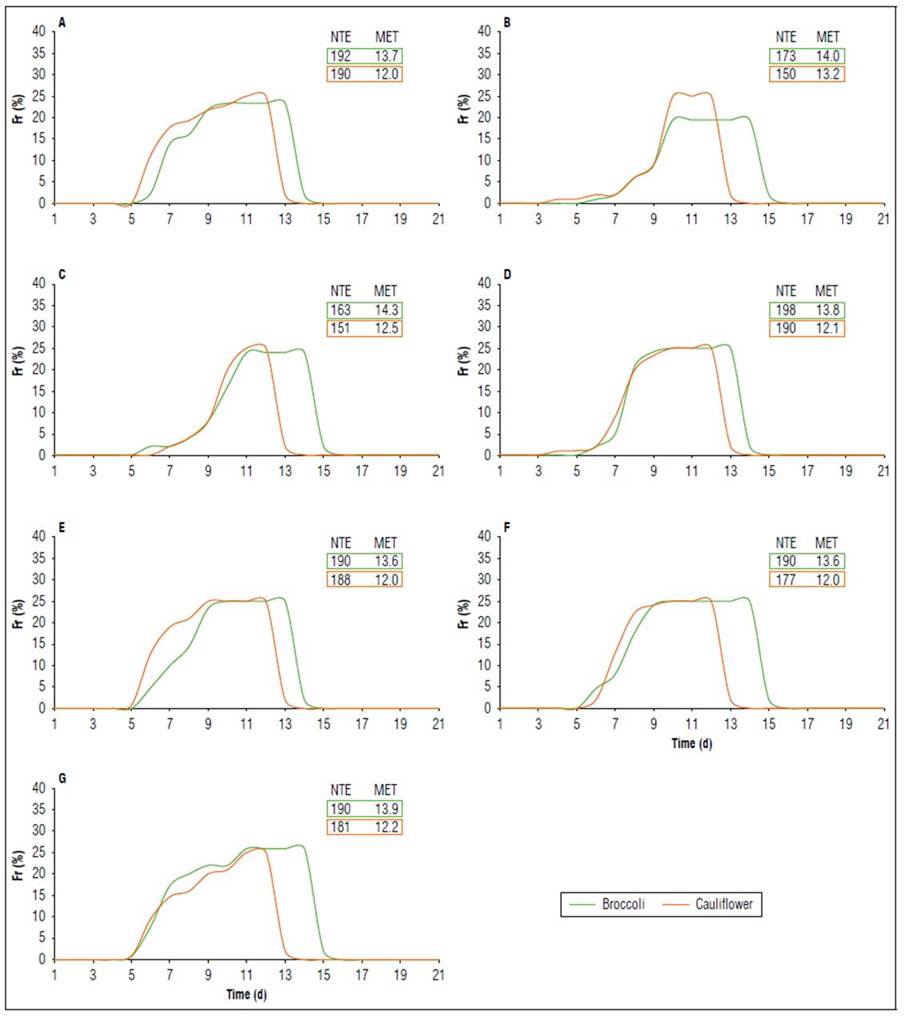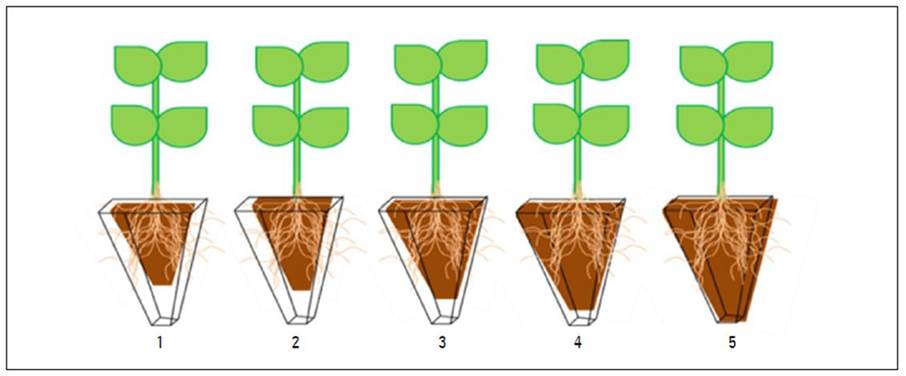INTRODUCTION
The botanical family Brassicaceae stands out for its importance in the production of vegetables, nutraceutical foods of socioeconomic function, for the presence of glucosinolates (sulfurized secondary metabolites), vitamins (A, C and K), for being a good source of fiber and for having a relatively low production cost. The Brassica genus has a wide variety of vegetables in terms of its final product, for example, leafy brassicas such as kale (Brassica oleracea var. acephala L.), terminal bud brassicas such as cabbage (B. oleracea var. capitata L.), side-bud brassicas such as brussels sprouts (B. oleracea var. gemmifera), inflorescence brassicas such as broccolli (B. oleracea L. var. italica) and cauliflower (B. oleracea L. var. botrytis), among others (Filgueira, 2013; Rodrigues, 2019).
Broccoli and cauliflower (Fig. 1) are among the most consumed edible flowers in the world, as they are rich in fiber and vitamins. The average inflorescence consumption of both species in Brazil is approximately 1.0 kg/year per inhabitant, with an average production of 23 t ha-1, with seedling quality being a limiting factor for production (Franzen et al., 2019; Barros and Boteon, 2021).
The production of high-quality seedlings of these species involves several aspects, including the substrate and the form of irrigation. The substrate is the medium in which the seed is deposited and serves as a physical structure for the anchorage of the seedling. Its specific composition for each species must provide aeration and rational use of water for the full aerial and root development. Therefore, it is important to know the biological, chemical and physical characteristics of the materials that will compose the substrate, which must have good water retention and drainage. In general, the choice of these materials is based on availability in the region at low cost (Rodrigues, 2002; Kämpf et al., 2006; Takane et al., 2013).

Figure 1. Morphology of broccoli (B. oleracea L. var. italica; A) and cauliflower (B. oleracea L. var. botrytis; B). Source: Adapted fromhttps://ceagesp.gov.br/wp-content/uploads/2020/05/variedades_couve-flor-1.jpg[A] ehttps://ceagesp.gov.br/wp-content/uploads/2020/05/brocolis-1.jpg[B].
Irrigation is essential in the production of seedlings, and its interaction with the substrate-plant-atmosphere system helps to understand the plant’s response mechanisms to different environmental factors. In recent years, research has been developed in several irrigation systems, including the Deep Film Technique (DFT) method, which consists of partially submerging the cultivation container in a water slide or nutrient solution, for a determined time, allowing irrigation of plants by moistening the substrate. An adaptation of this method for seedling production was made, in which there is elevation and drainage of the water flow several times a day (Bezerra and Barreto, 2011; Santos, 2012).
Broccoli and cauliflower species have their productivity negatively affected by water deficit, therefore the monitoring of water availability is necessary from the seedling stage (May et al., 2007). In the DFT irrigation method, the interaction of water in the substrate-plant-atmosphere system favors the development of seedlings, enhancing aeration and humidity in the root system. Furthermore, the method avoids the occurrence of some diseases, as there is no leaf wetness. Therefore, DFT irrigation is widely used in the production of vegetable and ornamental seedlings, including those intended for hydroponic production (Rodrigues, 2002; Marouelli et al., 2014). Thus, the objective of this work was to evaluate broccoli and cauliflower seedling emergence and production using different substrates with the application of the DFT irrigation method on a table.
MATERIALS AND METHODS
The experiment was carried out from July to September 2021, in the Polytechnic College Olericulture Sector, at the Federal University of Santa Maria (UFSM), located in Santa Maria, RS (29º43' S; 53º43' W and altitude of 95 m). The climate in the region is humid subtropical (Cfa), according to the Köppen-Geiger classification, with average annual rainfall of 1,769 mm, average annual temperature close to 19.2ºC and air humidity around 78.4% (Alvares et al., 2013).
The experiment was carried out in a greenhouse (average temperature of 26.3º C and air humidity 88%), at a completely randomized design, organized in a 7×2 factorial scheme (substrate compositions and inflorescence brassica species), with four replications. Each experimental unit consisted of 50 seeds/seedlings. Substrate compositions were in volumetric proportions of 1:0:0; 0:1:0; 0:0:1; 1:1:1; 1:1:0; 1:0:1 and 0:1:1, with the commercial substrate Carolina Soil®, carbonized rice husk (CAC) and medium texture sand, respectively (Tab. 1). Seeds of cultivars Híbrido Titanium and Piracicaba precocious were used for broccoli and cauliflower, respectively.
Table 1 Substrate material properties.
| Parameters | Commercial substrate Carolina Soil® | Carbonized rice husk (CAC) | Medium texture sand |
|---|---|---|---|
| Density | 500 kg m-3 | 300 kg m-3 | 1,400 kg m-3 |
| Porosity | 85% | 80% | 31% |
| Aeration space | 25% | 65% | 67% |
| Water holding capacity | 39% | 20% | 10% |
| Pores/solids (P/S) ratio | 5.7 | 4.0 | 2.0 |
Source: adapted from Kämpf et al. (2006) and Takane et al. (2013).
Sowings were carried out in expanded polystyrene (styrofoam) trays with 200 wells (15.58 mL volume, 5 cm high, pyramid-shape cell, with the seed buried at 1 cm) containing substrates, using one seed per well. Irrigations were carried out three times a day for 30 min each, in order to increase water flow and its subsequent drainage, using the Deep Film Technique (DFT) method on a table with 3 cm of water only, without the use of nutrient solution. The irrigation water presented electrical conductivity (EC) of 0.61 dS m-1.
The following parameters were evaluated: counts of seedlings emerged daily, until their emergence was stabilized at 21 days after sowing (DAS), this period was used to calculate the emergence speed index (ESI) (Maguire, 1962) and mean emergence time (MET; days) (Furbeck et al., 1993), the mean daily emergence speed (MES) expressed in the Equation [MES= 1/MET], in which: MES = mean emergence speed; MET = mean emergence time; and the relative emergence frequency (Fr) expressed in Equation [Fr=ni/∑i=1k], in which: Fr = relative emergence frequency; ni = number of seedlings emerged per day; Σni = total number of emerged seedlings, both were determined by the methodology of Labouriau and Valadares (1976).
At 35 DAS, it was evaluated shoot and root lengths (cm), both measured with a millimeter ruler, the number of leaves (unit) by manual counting, and the stability of the clods in relation to the permanence of the clod in the container. To assess the stability of the clods, grades from 1 to 5 were assigned (Fig. 2), in which grade 1 corresponds to the substrate with the lowest stability and grade 5 to the best stability, as described below: grade 1: Low stability, above 50% of the clod is retained in the container, and the clod does not remain cohesive; grade 2: Between 10 and 30% of the clod is retained in the container, and the clod does not remain cohesive; grade 3: The clod detaches from the container, but does not remain cohesive; grade 4: The clod detaches from the container, but there is a loss of up to 10% of the substrate; grade 5: The entire clod is detached from the container and more than 90% of it remains cohesive (Menegaes et al., 2017).
The data expressed in percentage were transformed into arcsine, analysis of variance (ANOVA) and the comparison of means by the Scott-Knott test (P<0.05) were performed with the aid of the SISVAR statistical program (Ferreira, 2014).
RESULTS AND DISCUSSION
There was significant interaction between broccoli and cauliflower species and substrate compositions, except for mean emergence speed, as it can be seen in Table 2. It was observed that both species showed germination above 70% for all tested substrate compositions, confirming the minimum quality required by Ordinance nº. 111/2012 of the Ministry of Agriculture, Livestock and Supply (BRAZIL-MAPA, 2012), for a batch of horticultural seeds to be considered of commercial quality.
Table 2. Emergence, speed index (ESI), mean time (MET) and mean speed (MES) of emergence of broccoli (B. oleracea L. var. italica) and cauliflower (B. oleracea L. var. botrytis), subjected to different substrates.
| Composition of substrates a | Inflorescence brassica species | |||
|---|---|---|---|---|
| Broccoli | Cauliflower | Broccoli | Cauliflower | |
| Emergency (%) | ESI | |||
| 1:0:0 | 96* Ab | 95 Aa | 72.726 Aa | 76.634* Ab |
| 0:1:0 | 86 Ac | 79 Bc | 58.729 Ad | 62.404 Ac |
| 0:0:1 | 81 Ac | 77 Bc | 59.209 Ad | 62.218 Ac |
| 1:1:1 | 99 Aa | 94 Ba | 70.332 Ab | 81.391 Aa |
| 1:1:0 | 95 Ab | 95 Aa | 71.115 Aa | 76.828 Ab |
| 1:0:1 | 96 Ab | 89 Bb | 66.874 Bc | 75.193 Ab |
| 0:1:1 | 94 Ab | 90 Bb | 65.216 Bc | 72.561 Ab |
| CV (%) | 4,88 | 9,72 | ||
| MET (days) | MES (days-1) | |||
| 1:0:0 | 13.7* Ab | 12.5 Bb | 0.073 ns | 0.083 |
| 0:1:0 | 14.1 Aa | 13.2 Ba | 0.071 | 0.076 |
| 0:0:1 | 14.2 Aa | 12.5 Bb | 0.070 | 0.080 |
| 1:1:1 | 13.8 Ab | 12.1 Bc | 0.073 | 0.082 |
| 1:1:0 | 13.7 Ab | 12.2 Bc | 0.073 | 0.082 |
| 1:0:1 | 13.8 Ab | 12.0 Bc | 0.072 | 0.083 |
| 0:1:1 | 13.9 Ab | 12.3 Bc | 0.072 | 0.081 |
| CV (%) | 5,57 | 5,61 | ||
a Carolina Soil® commercial substrate, carbonized rice husk and medium textured sand, respectively.
*significant interaction and ns non-significant interaction of factors. Test of means not followed by the same letter, uppercase in the line and lowercase in the column, differ by the Scott-Knott test (P<0.05). CV: Coefficient of variation.
Seedling emergence at 21 DAS resulted in averages of 92 and 88% for broccoli and cauliflower, respectively, and averages of 95, 83, 79, 97, 95, 93 and 92% for the substrate compositions of 1:0:0; 0:1:0; 0:0:1; 1:1:1; 1:1:0; 1:0:1 and 0:1:1, respectively. These data corroborate the study of Menegaes et al. (2020; 2021), who evaluated the emergence of broccoli and cauliflower in different substrate compositions and water regimes. Average emergence percentages were greater than 70%, thus indicating good conditions for the production of seedlings of these species.
It was observed that the general averages of the emergence speed indices (ESI) were 72.461 and 66.314 for broccoli and cauliflower, respectively. Among the averages of substrate compositions, the volumetric proportion of 1:1:1 for broccoli, with emergence of 99% and the volumetric proportions of 1:0:0 and 1:1:0 for cauliflower, with emergence of 99%, stand out at 95%. In the mean emergence time (MET) of 13.9 for broccoli and 12.4 days for cauliflower, it was found that the mean emergence speed (MES) was not significant, with general means of 0.072 and 0.081 d-1.
The ESI, MET and MES parameters indicate that the cauliflower species presents faster seed germination and seedling emergence than the broccoli species, under the aforementioned experimental conditions. This can be confirmed in figure 3, where the percentages of the relative frequencies (Fr) of emerged seedlings indicate the anticipation of the cauliflower emergence peaks in relation to the broccoli emergence peaks, which on average reach in the MET of 12 .4 and 13.9 days, respectively.

Figure 3. Relative frequencies (Fr; %) of emerged broccoli (B. oleracea L. var. italica) and cauliflower (B. oleracea L. var. botrytis) seedlings, subjected to different substrates. NTE: number of emerged seedlings (units), MET: mean emergence time (days).
These results were similar to those of Menegaes et al. (2020; 2021). The authors observed that the overall METs were 12.0 and 13.8 days for cauliflower and broccoli, respectively, which are similar to our results. The authors also emphasize that there is a tendency for the relative frequencies to express their maximum physiological potential at the peak of emergence, thus coinciding with the MET mean. From this period, maximum seed germination and seedling emergence occurred for the consequent formation of seedlings.
According to Filgueira (2013), for vegetable species such as broccoli and cauliflower, a homogeneous emergence of seedlings allows for a good plant stand formation in the field. For Marcos Filho (2015), the meteorological conditions during the seedling formation period can affect the expression of the physiological potential of the seeds, especially in the parameters of time and speed of emergence, with a direct implication in the quality of the seedlings.
Seed germination and seedling emergence vary according to the substrate composition (Fig. 3). Since the substrates contained different volumetric proportions of the commercial substrate Carolina Soil®, CRH and medium texture sand, they presented different percentages of aeration and porosity. These percentages, when added to the DFT irrigation method, provided a difference in water availability in relation to water retention and drainage, affecting sometimes positively and sometimes negatively the humidity of the substrate and the root system of the plants.
According to Kämpf et al. (2006) and Takane et al. (2013), the aeration and porosity characteristics of a substrate start with the choice of its constituents and, mainly, its proportions, which will favor all water availability for plants, in all their phenological stages. Fiorin et al. (2021) found that the different volumetric compositions of substrate, containing commercial substrate and medium-textured sand, affected the full development of lettuce seedlings (Lactuca sativa L.), where emergence peaks were 9.7 and 12.2 days for seeds with and without pelleting, respectively.
Table 3 shows the averages of the stability scores of the seedling clod at 35 DAS, for both species. The substrate compositions of 1:0:0, 1:1:1 and 1:1:0 obtained clod stability scores of 4.0 and 3.9, respectively, for broccoli, and the composition 1:0:0 presented a score of 3.6 for cauliflower. In these aforementioned compositions, the seedlings’ clods contained good cohesion in the substrate-plant-container-water system (Fig. 2). According to Menegaes et al. (2017), the cohesion of this system is the result of its interaction, providing the clod stability after its removal from the container, favoring the quality of the seedlings and the success of their “sticking” in the field after transplanting.
Table 3. Clod stability, shoot and root lengths and number of leaves of broccoli (B. oleracea L. var. italica) and cauliflower (B. oleracea L. var. botrytis) seedlings, submitted to different substrates.
| Composition of substrates a | Inflorescence brassica species | |||
|---|---|---|---|---|
| Broccoli | Cauliflower | Broccoli | Cauliflower | |
| Clod stability (note) | Length of aerial part (cm) | |||
| 1:0:0 | 4,0 *Aa | 3,6 Ba | 1,8* Aa | 1,5 Aa |
| 0:1:0 | 1,8 Ad | 1,7 Ac | 1,0 Ad | 1,1 Ab |
| 0:0:1 | 1,8 Ad | 1,7 Ac | 1,0 Ad | 1,1 Ab |
| 1:1:1 | 4,0 Aa | 2,8 Bb | 1,3 Ac | 1,4 Aa |
| 1:1:0 | 3,9 Ab | 2,5 Bb | 1,5 Ab | 1,5 Aa |
| 1:0:1 | 3,1 Ac | 1,8 Bc | 1,6 Ab | 1,4 Aa |
| 0:1:1 | 1,8 Ad | 1,7 Ac | 1,1 Ad | 1,2 Ab |
| CV (%) | 4,43 | 4,78 | ||
| Length of root part (cm) | Number of leaves (units) | |||
| 1:0:0 | 6,2* Ab | 6,1 Aa | 3,1 *Ac | 3,2 Aa |
| 0:1:0 | 5,4 Ac | 5,1 Ab | 2,9 Ad | 2,8 Ac |
| 0:0:1 | 6,5 Aa | 3,6 Bc | 3,4 Ab | 3,3 Aa |
| 1:1:1 | 6,6 Aa | 5,8 Bb | 3,5 Aa | 2,9 Ac |
| 1:1:0 | 6,6 Aa | 5,5 Bb | 3,6 Aa | 2,8 Ac |
| 1:0:1 | 6,5 Aa | 5,5 Bb | 3,5 Aa | 2,8 Ac |
| 0:1:1 | 5,8 Bc | 6,1 Aa | 2,9 Ad | 3,1 Ab |
| CV (%) | 3,37 | 3,18 | ||
a Carolina Soil® commercial substrate, carbonized rice husk (CRH) and médium-textured sand, respectively.
* significant interaction and ns non-significant interaction of factors. Test of means not followed by the same letter, uppercase in the line and lowercase in the column, differ by the Scott-Knott test (P<0.05). CV: Coefficient of variation.
The production period of broccoli and cauliflower seedlings varies from 30 to 40 d, depending on the time of year (Filgueira, 2013). In the present experiment, it was verified that there was good seedling development at 35 DAS, with average shoot lengths of 1.3 cm for both species and with average root lengths of 6.2 and 5.4 cm, and the number of leaves of 3.3 and 3.0 for broccoli and cauliflower, respectively.
CONCLUSION
The tabletop DFT irrigation method and the different substrate compositions were beneficial for the emergence of seedlings and the formation of broccoli and cauliflower seedlings. In general, there was good seed germination and seedling development, in which, for both species, the substrate compositions of 1:0:0; 1:1:1 and 1:1:0 (commercial substrate Carolina Soil®, carbonized rice husk and medium texture sand) are recommended.
















